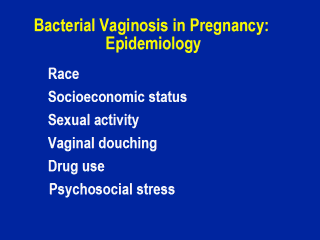| front |1 |2 |3 |4 |5 |6 |7 |8 |9 |10 |11 |12 |13 |14 |15 |16 |17 |18 |19 |20 |21 |22 |23 |24 |25 |26 |27 |28 |29 |30 |31 |review |
 |
1. Race:
Mmeasuring BV at 23-26 weeks found 2 -2.5 times higher among African
American vs. white women 2. Disadvantage women have higher rates of BV: among OB population 10% prevalence among private patients an 32% prevalence among indigent women (symptomatic BV) 3. Sexual activity (ie. early sexual activity, high number of lifetimesexual partners, women with new sex partners, STD’s). Not a considered or proven to be an STD: school-based study (12% virgin school girls vs. 15% nonvirgin school girls) and lesbians a traditional low std population. Although trich and BV commonly seen together and the anaerobic organisms (primarily H. vaginalis and G. vaginalis) have been cultured from the male partners of women with BV. But treatment of male partners is not a reliable way to reduce recurrence. 4. Douching rates 5. VIPS also found pregnant women with BV were more likely to report cigarette use and alcohol consumption; although the differences were marginal (16% vs. 14%) |